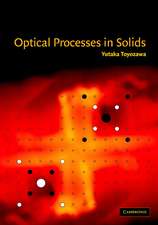Structure Determination by X-Ray Crystallography
Autor R. a. Palmer, M. F. C. Ladden Limba Engleză Paperback – 7 mai 2012
Preț: 650.55 lei
Preț vechi: 765.36 lei
-15% Nou
Puncte Express: 976
Preț estimativ în valută:
124.49€ • 129.13$ • 103.80£
124.49€ • 129.13$ • 103.80£
Carte tipărită la comandă
Livrare economică 27 martie-10 aprilie
Preluare comenzi: 021 569.72.76
Specificații
ISBN-13: 9781461579410
ISBN-10: 1461579414
Pagini: 528
Ilustrații: XXIV, 502 p. 22 illus.
Dimensiuni: 152 x 229 x 28 mm
Greutate: 0.7 kg
Ediția:1985
Editura: Springer Us
Colecția Springer
Locul publicării:New York, NY, United States
ISBN-10: 1461579414
Pagini: 528
Ilustrații: XXIV, 502 p. 22 illus.
Dimensiuni: 152 x 229 x 28 mm
Greutate: 0.7 kg
Ediția:1985
Editura: Springer Us
Colecția Springer
Locul publicării:New York, NY, United States
Public țintă
ResearchCuprins
1 Crystal Geometry. I.- 1.1 Introduction.- 1.2 The Crystalline State.- 1.3 Stereographic Projection.- 1.4 External Symmetry of Crystals.- Problems.- 2 Crystal Geometry.II.- 2.1 Introduction.- 2.2 Lattices.- 2.3 Families of Planes and Interplanar Spacings.- 2.4 Reciprocal Lattice.- 2.5 Rotational Symmetries of Lattices.- 2.6 Space Groups.- Problems.- 3 Preliminary Examination of Crystals by Optical and X-Ray Methods.- 3.1 Introduction.- 3.2 Polarized Light.- 3.3 Optical Classification of Crystals.- 3.4 Direction of Scattering of X-Rays by Crystals.- 3.5 X-Ray Techniques.- 3.6 Recognition of Crystal System.- Problems.- 4 Intensity of Scattering of X-Rays by Crystals.- 4.1 Introduction.- 4.2 Path Difference.- 4.3 Mathematical Representation of a Wave: Amplitude and Phase.- 4.4 Combination of Two Waves.- 4.5 Argand Diagram.- 4.6 Combination of N Waves.- 4.7 Combined Scattering of X-Rays from the Contents of the Unit Cell.- 4.8 Structure Factor.- 4.9 Intensity Expressions.- 4.10 Phase Problem in Structure Analysis.- 4.11 Applications of the Structure Factor Equation.- 4.12 Preliminary Structure Analysis.- Problems.- 5 Methods in X-Ray Structure Analysis. I.- 5.1 Introduction.- 5.2 Analysis of the Unit-Cell Contents.- 5.3 Two Early Structure Analyses Revisited.- Problems.- 6 Methods in X-Ray Structure Analysis. II.- 6.1 Introduction.- 6.2 Fourier Series.- 6.3 Representation of Crystal Structures by Fourier Series.- 6.4 Methods of Solving the Phase Problem.- Problems.- 7 Direct Methods and Refinement.- 7.1 Introduction.- 7.2 Direct Methods of Phase Determination.- 7.3 Patterson Search Methods.- 7.4 Least-Squares Refinement.- 7.5 Molecular Geometry.- 7.6 Precision.- 7.7 Correctness of a Structure Analysis.- 7.8 Limitations of X-Ray Structure Analysis.- 7.9 Disorder in Single Crystals.- Problems.- 8 Examples of Crystal Structure Analysis.- 8.1 Introduction.- 8.2 Crystal Structure of 2-Bromobenzo[b]indeno[1,2-e]pyran (BBIP).- 8.3 Crystal Structure of Potassium 2-Hydroxy-3,4-dioxocyclobut-1-ene-1-olate Monohydrate (KHSQ).- 8.4 Concluding Remarks.- Problems.- A.1 Stereoviews and Crystal Models.- A1.1 Stereoviews.- A1.2 Model of a Tetragonal Crystal.- A1.3 Stereoscopic Space-Group Drawings.- A.2 Crystallographic Point-Group Study and Recognition Scheme.- A.3 Schoenflies’ Symmetry Notation.- A3.1 Alternating Axis of Symmetry.- A3.2 Notation.- A.4 Generation and Properties of X-Rays.- A4.1 X-Rays and White Radiation.- A4.2 Characteristic X-Rays.- A4.3 Absorption of X-Rays.- A4.4 Filtered Radiation.- A.5 Crystal Perfection and Intensity Measurement.- A5.1 Crystal Perfection.- A5.2 Intensity of Reflected Beam.- A5.3 Intensity Measurements.- A5.3.1 Film Measurements.- A5.3.2 Diffractometer Geometry and Data Collection.- A5.4 Data Processing.- A5.4.1 Introduction.- A5.4.2 Standard Deviation of Intensity.- A5.4.3 Absorption Corrections.- A5.4.4 Scaling.- A5.4.5 Merging Equivalent Reflections.- A5.5 Synchrotron Radiation.- A.6 Transformations.- A.7 Comments on Some Orthorhombic and Monoclinic Space Groups.- A7.1 Orthorhombic Space Groups.- A7.2 Monoclinic Space Groups.- A.8 Vector Algebraic Relationships in Reciprocal Space.- A8.1 Introduction.- A8.2 Reciprocal Lattice.- A8.2.1 Interplanar Spacings.- A8.2.2 Reciprocity of Unit Cell Volumes.- A8.2.3 Angle between Bravais Lattice Planes.- A8.3 X-Ray Diffraction and the Reciprocal Lattice.- A8.3.1 Bragg’s Equation.- A8.4 Laue Photographs.- A8.5 Crystal Setting.- A8.5.1 Setting Technique.- A.9 Intensity Statistics.- A9.1 Weighted Reciprocal Lattice.- A9.1.1 Laue Symmetry.- A9.1.2 Systematic Absences.-A9.1.3 Accidental Absences.- A9.1.4 Enhanced Averages.- A9.1.5 Special Distributions.- A.10 Enantiomorph Selection.- Solutions.

















